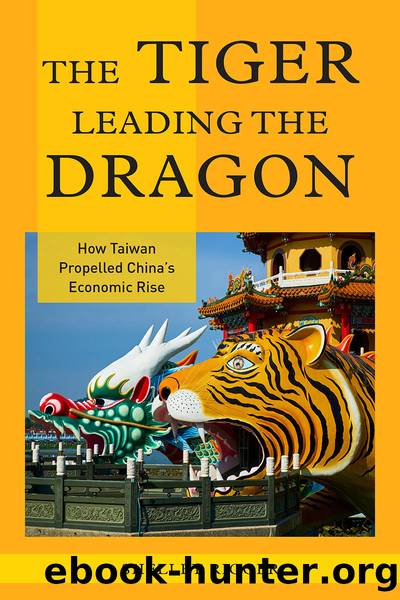The Tiger Leading the Dragon by Shelley Rigger;

Author:Shelley Rigger;
Language: eng
Format: epub, pdf
Publisher: Rowman & Littlefield Publishing Group, Inc.
Published: 2021-05-22T00:00:00+00:00
The PRC governs its economy with Five Year Plans. The eleventh Five Year Plan, which covered the period from 2006 through 2010, revealed Beijingâs intention to take Chinaâs economy back from foreign investors. The plan was concrete proof of something many Taiwanese had suspected for some time: Beijing was no longer prioritizing Taiwanese and other foreign investment. After decades of special treatment, Taishang were starting to find themselves competing on a level playing fieldâand in some cases, on a playing field tilted in favor of PRC domestic firms. Across a range of industriesâfrom steel and petrochemicals to equipmentâChinaâs imports from Taiwan were steadily declining in favor of domestic production.
For decades, the primary concern for Taiwanese authorities was finding ways to help Taishang access opportunities in China. Increasingly, though, the challenge for Taiwanese firms was not market access or the overall business environment but competitiveness. The Taishang mantra âcost downâ was nothing new, but the pressure to lower costs intensified as domestic PRC firms made their way into supply chains. By the time Ma took office in 2008, Taishang had a new buzzword: âtransformational upgradingâ (zhuanxing shengji). Transformational upgrading means moving up the value chain in order to remain competitive and profitable even as the cost of production in China rises. Firms that failed to transform and upgrade would not survive the surging growth of PRC firms.
Another option for Taishangâespecially after the financial crisis of 2008 exposed the fragility of their established markets in North America and Europeâwas to focus on Chinaâs domestic market, a topic I explore in chapter 8. Moving into the domestic market forced Taishang out of the relatively protected export-oriented sector and put them in direct competition with PRC firms. Meanwhile, Maâs market-opening reforms allowed some PRC-based firms to operate in Taiwan, forcing Taiwanese firms to compete in both markets.
During Maâs presidency, management consultants and government officials redoubled their advice to Taishang to undertake transformational upgrading in order to remain competitive in an ever-more-challenging PRC market. The advice was extensive but not always consistent. Management scholars Lu Hong-de and Luo Huai-chia advised businesses to think of the years 2011 to 2015 as âTaishang 3.0â and to take their cues from Beijingâs twelfth Five Year Plan by switching to services, finance, and green manufacturing and by moving operations farther into the Chinese interior. Chang Pao-cheng of Taiwanâs China Productivity Center recommended upgrading Taishang management practices to become more efficient, up-to-date, and service-oriented.11 It was good advice, no doubt, but not easy to put into practice.
One industry that took this advice to heart was bicycle manufacturing. Taiwanâs bicycle industry has been part of the scene almost from the beginning of Taiwanâs industrial age. Early on, Taiwanese firms did contract manufacturing for global brands such as Raleigh, Schwinn, and Trek. In 1972, King Liu founded one such contract manufacturer, Giant, in a small town in central Taiwan called Tachia. In the early 1980s, Liu transformed Giant from a contract manufacturer to a branded company, opening its first international sales operation in the Netherlands in 1986.
Download
The Tiger Leading the Dragon by Shelley Rigger;.pdf
This site does not store any files on its server. We only index and link to content provided by other sites. Please contact the content providers to delete copyright contents if any and email us, we'll remove relevant links or contents immediately.
| Accounting | Economics |
| Exports & Imports | Foreign Exchange |
| Global Marketing | Globalization |
| Islamic Banking & Finance |
The Meaning of the Library by unknow(2385)
Six Billion Shoppers by Porter Erisman(2224)
Why Nations Fail: The Origins of Power, Prosperity, and Poverty by Daron Acemoglu & James Robinson(2170)
No Time to Say Goodbye(1996)
Red Notice by Bill Browder(1924)
The Economist [T6, 22 Thg9 2017] by The Economist(1843)
Currency Trading For Dummies by Brian Dolan(1788)
Thank You for Being Late by Thomas L. Friedman(1675)
Bitcoin: The Ultimate Guide to the World of Bitcoin, Bitcoin Mining, Bitcoin Investing, Blockchain Technology, Cryptocurrency (2nd Edition) by Ikuya Takashima(1611)
Amazon FBA: Amazon FBA Blackbook: Everything You Need To Know to Start Your Amazon Business Empire (Amazon Empire, FBA Mastery) by John Fisher(1491)
Coffee: From Bean to Barista by Robert W. Thurston(1418)
The Future Is Asian by Parag Khanna(1397)
The Great Economists by Linda Yueh(1389)
Capitalism Without Capital: The Rise of the Intangible Economy by Jonathan Haskel(1337)
Pocket World in Figures 2018 by The Economist(1325)
How Money Got Free: Bitcoin and the Fight for the Future of Finance by Brian Patrick Eha(1322)
Grave New World by Stephen D. King(1314)
The Sex Business by Economist(1279)
Cultural Intelligence by David C. Thomas(1201)
